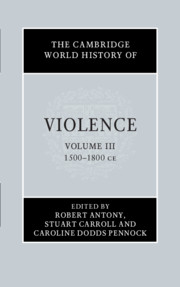Book contents
- The Cambridge World History of Violence
- The Cambridge World History of Violence
- The Cambridge World History of Violence
- Copyright page
- Contents
- Figures
- Maps
- Contributors to Volume iii
- Introduction to Volume iii
- Part I Empire, Race and Ethnicity
- Part II Cultures of War and Violence
- Part III Intimate and Gendered Violence
- Part IV The State, Punishment and Justice
- Part V Popular Protest and Resistance
- Part VI Religious and Sacred Violence
- Part VII Representations and Constructions of Violence
- 29 African Ritual Violence: Close Combat in Western Africa and the Diaspora
- 30 Intercultural Emblems of Violence in the Spanish Colonisation of the Americas
- 31 Spectacles of Violence in China
- 32 Visualising Violence in Reformation Europe
- 33 Violence, Civil Society and European Civilisation
- Index
- References
32 - Visualising Violence in Reformation Europe
from Part VII - Representations and Constructions of Violence
Published online by Cambridge University Press: 13 March 2020
- The Cambridge World History of Violence
- The Cambridge World History of Violence
- The Cambridge World History of Violence
- Copyright page
- Contents
- Figures
- Maps
- Contributors to Volume iii
- Introduction to Volume iii
- Part I Empire, Race and Ethnicity
- Part II Cultures of War and Violence
- Part III Intimate and Gendered Violence
- Part IV The State, Punishment and Justice
- Part V Popular Protest and Resistance
- Part VI Religious and Sacred Violence
- Part VII Representations and Constructions of Violence
- 29 African Ritual Violence: Close Combat in Western Africa and the Diaspora
- 30 Intercultural Emblems of Violence in the Spanish Colonisation of the Americas
- 31 Spectacles of Violence in China
- 32 Visualising Violence in Reformation Europe
- 33 Violence, Civil Society and European Civilisation
- Index
- References
Summary
Depictions of violence were ubiquitous in sixteenth-century Europe and drew freely on biblical and classical sources, as well as stories of Christian martyrdom. The new media of print and printmaking dramatically increased the number of such images, while pamphlets and broadsheets ensured their widespread circulation and deployment in the service of propaganda and the reporting of sensational crimes and disasters. The outbreak of polemic and conflict associated with the Reformation also provided new markets for the visualising of violence. The fascination with soldiers and war was driven by developments in arms technology and the desire of princely patrons to emulate the valour of the ancients. Whereas battle scenes in the first half of the century were largely conventional, the outbreak of confessional wars in the second brought images of gruesome violence, wholesale destruction and massacre, in which cities and the countryside were laid waste. While the use of violence for confessional propaganda never disappeared, the cruelty, desolation and terrible miseries endured by populations at the hands of ravaging soldiers during the Dutch Revolt and the Thirty Years War gradually became the object of fierce critique by artists in the early seventeenth century, drawing parallels with Spanish savagery in the Americas.
- Type
- Chapter
- Information
- The Cambridge World History of Violence , pp. 634 - 659Publisher: Cambridge University PressPrint publication year: 2020



